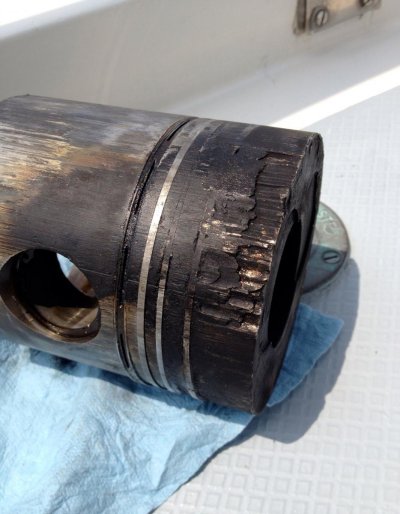Dickhein
Member
One day after an afternoon out motoring on our 1979 Defever 43 we pulled into the slip and I got ready to shut down the engines. I noticed a knock in the port engine.
I checked the injectors at a local shop and they were ok. No indication of coolant loss, and water was exiting the exhaust. Impeller had less than 50 hours. Exhaust elbow was fairly new. Oil looked ok. Had to bring in a mechanic at this point.
To make a long story short, the #6 piston was destroyed and the cylinder scored evidently due to overheating. This came as quite a surprise as the temperature gauge had not indicated an overheat situation. So we replaced the piston and rod and honed the cylinder. Started right up and sounded fine. About 5 hours later the knock was back. We ran into Bob Smith at the Fall MTOA rendezvous and he came aboard and listened. His thought was maybe the water jackets were clogged from running the engines at 1400 (low) rpm, which I do, but have the mechanic check it out.
The mechanic returned and said the cylinder was scored in the same place as before. We removed the rear freeze plug and the water jackets were clean. So I'm out about 4 boat units and no closer to solving the problem than before and still have a sick engine. Anybody have any thoughts?
I checked the injectors at a local shop and they were ok. No indication of coolant loss, and water was exiting the exhaust. Impeller had less than 50 hours. Exhaust elbow was fairly new. Oil looked ok. Had to bring in a mechanic at this point.
To make a long story short, the #6 piston was destroyed and the cylinder scored evidently due to overheating. This came as quite a surprise as the temperature gauge had not indicated an overheat situation. So we replaced the piston and rod and honed the cylinder. Started right up and sounded fine. About 5 hours later the knock was back. We ran into Bob Smith at the Fall MTOA rendezvous and he came aboard and listened. His thought was maybe the water jackets were clogged from running the engines at 1400 (low) rpm, which I do, but have the mechanic check it out.
The mechanic returned and said the cylinder was scored in the same place as before. We removed the rear freeze plug and the water jackets were clean. So I'm out about 4 boat units and no closer to solving the problem than before and still have a sick engine. Anybody have any thoughts?



